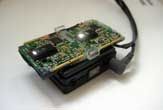Twist, Flick, Tap: New Way to Operate Mobile Electronics

A new technology based on the sensor found in many computer mice makes interacting with a MP3 player or mobile phone as easy as flicking, twisting or tapping the device.
Called Minput, the technology could find its way into a next-generation smart phone within a year, the researchers said.
Using gestures to interact with mobile electronics isn’t new. Rotating an iPhone, for example, changes the display orientation from portrait to landscape. But the type of sensor responsible for this in the iPhone — called an accelerometer — has a “very low resolution,” said Chris Harrison, a Ph.D. student at Carnegie Mellon University who developed the method with Scott Hudson, a professor at the university.
“They are good for things like orientation, but very poor for things like cursor control,” Harrison said.
But optical sensors, which are used for detecting motion in many computer mice, have extremely high resolution – enabling such functions as scrolling through songs and browsing through photos on smaller devices.
Shrinking
Advancements in electronics have turned bulky, wireless phones into sleek, thin packages (remember those huge mobile phones we still see in 80s movies!). But packing more processing power into ever-smaller spaces, however, can only go so far.
Sign up for the Live Science daily newsletter now
Get the world’s most fascinating discoveries delivered straight to your inbox.
“If you had an iPhone the size of a wristwatch, the reason why you wouldn’t be able to use it isn’t because you couldn’t fit the computer processor or batteries inside of it, but because you’d lose the ability to do multi-touch on such a small screen,” Harrison said.
With a small touch screen, “not only are you inaccurate, but you end up covering half the screen [with your finger], so you can’t see what you’re trying to press even if you are accurate," Harrison said.
The search for an answer to this conundrum has led to several solutions, all of which fall short in one way or another, he added.
Minput
The new technology takes the well-developed technology used in optical mice and applies it in a new way, Harrison told TechNewsDaily.
“A lot of the tough engineering has been done for us," he said.
A good way to think about the new device is as a tool like a mouse or stylus. Compare using your finger versus a pen or stylus to write a message in freehand on a touch screen. You’d be able to write much smaller and more accurately with a pen.
“That’s because our fingers have a lot of dexterity when you grab a tool, but they’re very inaccurate if you’re kind of just poking with your finger,” Harrison said. “What we’re doing is … basically turning the whole device into something sort of like a pen."
Flicking, twisting and tapping
To test the technology, the researchers created a prototype by mounting two optical sensors on the back of a wristwatch, which was modified to include a music player, a photo-browsing device, and a cursor-type interface.
By simply dragging the prototype wristwatch across a desk or other surface, users could browse through songs and photos. And twisting was used as a zoom function, similar to twisting a lens on a camera.
The researchers envision the Minput technology being integrated into next-generation smart phones.
“These sensors would be built into devices in the same way that Apple built a microphone or camera into their iPhone,” Harrison said.
And it shouldn’t be more than a year or two before Minput is in your hands. According to Harrison, they’re already talking to companies that want to add it to their next-generation phones.
The researchers presented a paper on Minput at a recent conference on Human Factors in Computing Systems held in Atlanta, Georgia.
- 10 Profound Innovations Ahead
- Toe Mouse Designed for Hands-Free Computer Input
- Beyond the Mouse: 5 Ways We'll Interface With Future Computers












